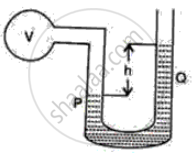Advertisements
Advertisements
प्रश्न
The atmospheric pressure at a place is 650 mm of Hg. Calculate this pressure in Pascals (Pa).
उत्तर
Height of mercury column = h = 650 mm
h = 65 cm = 0.65 m
Density of mercury = ρ= 13600 kg/m3
Acceleration due to gravity = g = 10 ms−2
Pressure (P) = 650 mm of Hg = hρg
= 0.65 × 13600 × 10
= 88400 Pa
APPEARS IN
संबंधित प्रश्न
A piece of wood is floating in water kept in a bottle. The bottle is connected to an air pump. Neglect the compressibility of water. When more air is pushed into the bottle from the pump, the piece of wood will float with
Explain the working of a hydraulic brake with a simple labelled diagram.
What should be the ratio of area of cross section of the master cylinder and wheel cylinder of a hydraulic brake so that a force of 15 N can be obtained at each of its brake shoe by exerting a force of 0.5 N on the pedal ?
If the mechanical advantage of the handle of the pump plunger is 8, calculate the force applied at the end of the handle of the pump plunger.
The following figure shows a manometer containing a liquid of density p. The limb P of the manometer is connected to a vessel V and the limb Q is open to atmosphere. The difference in the levels of liquid in the two limbs of the manometer is h as shown in the diagram. The atmospheric pressure is P0.
(i) What is the pressure on the liquid surface in the limb Q?
(ii) What is the pressure on the liquid surface in the limb P?

What are the factors on which the pressure of a liquid depends?
For what purpose is the acid battery hydrometer used?
